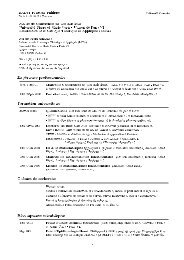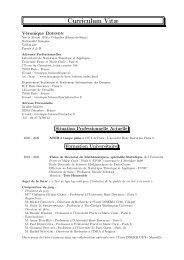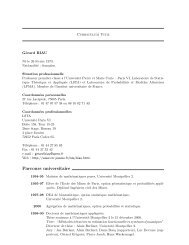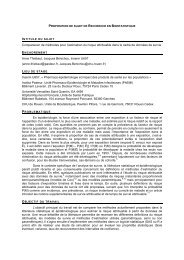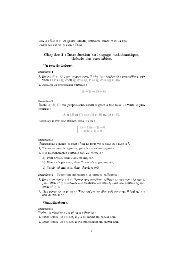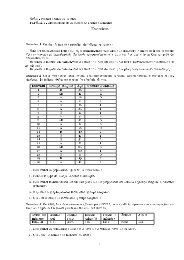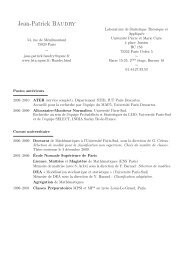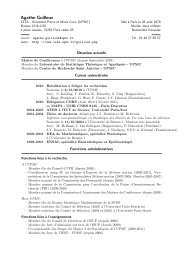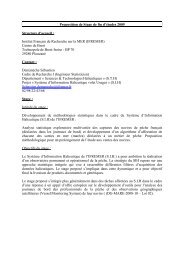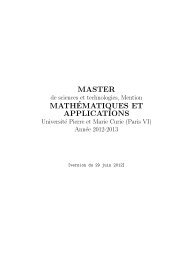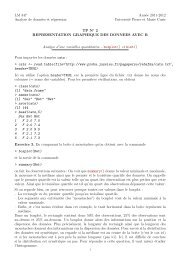Approximate Estimation in Generalized Linear Mixed Models ... - Lsta
Approximate Estimation in Generalized Linear Mixed Models ... - Lsta
Approximate Estimation in Generalized Linear Mixed Models ... - Lsta
Create successful ePaper yourself
Turn your PDF publications into a flip-book with our unique Google optimized e-Paper software.
ELSEVIERAn Intemational JournalAvailable onl<strong>in</strong>e at www.sciencedirect.com computers &.c,..c. (~o,..r mathematicswith applicationsComputers and Mathematics with Applications 51 (2006) 269-278www.elsevier.com/locate/camwa<strong>Approximate</strong> <strong>Estimation</strong> <strong>in</strong><strong>Generalized</strong> L<strong>in</strong>ear <strong>Mixed</strong> <strong>Models</strong> withApplications to the Rasch ModelM. L. FEDDAGDepartment of StatisticsUniversity of WarwickCoventry CV4 7AL, U.K.M-L. f eddag9 ac. ukIV[. iVl ES BAHLSTA University of Paris 6175 rue de Chevaleret, 75013 Paris, Francemesbah9 jussieu, frAbstract--This article discusses two different approaches to estimate the difficulty parameters(fixed effects parameters) and the variance of latent traits (variance components) <strong>in</strong> the mixed Ranchmodel. The first one is the generalized estimat<strong>in</strong>g equations (GEE2) which uses an approximation ofthe marg<strong>in</strong>al likelihood to derive the jo<strong>in</strong>t moments whilst the second approach uses the maximumof the approximate likelihood. We illustrate these methods with a simulation study and with ananalysis of real data from a quality of life. (~) 2006 Elsevier Ltd. All rights reserved.Keywords--<strong>Generalized</strong> l<strong>in</strong>ear mixed models, Cluster data, Fixed effects, Variance components,<strong>Generalized</strong> estimat<strong>in</strong>g equations (GEE), <strong>Approximate</strong> likelihood, IRT models, Ranch model, Qualityof life.1. INTRODUCTION<strong>Generalized</strong> l<strong>in</strong>ear mixed models (GLMMs) are extensions of generalized l<strong>in</strong>ear models (GLMs)that accommodate correlated and overdispersed data by add<strong>in</strong>g random effects to the l<strong>in</strong>ear predictor.Their broad applications are useful <strong>in</strong> various discipl<strong>in</strong>es, such as the analysis of clustereddata <strong>in</strong>clud<strong>in</strong>g longitud<strong>in</strong>al data or repeated measures. These models are useful for accommodat<strong>in</strong>gthe overdispersion often observed among outcomes that nom<strong>in</strong>ally have b<strong>in</strong>omial or Poissondistribution and for modell<strong>in</strong>g the dependence among outcome variables <strong>in</strong> longitud<strong>in</strong>al or repeatedmeasures designs. Such generalized l<strong>in</strong>ear mixed models are also <strong>in</strong>creas<strong>in</strong>gly used <strong>in</strong>various fields where subjective variables (called latent traits) need to be measured us<strong>in</strong>g questionnaireswith polychotomous items. This is usual <strong>in</strong> health sciences and cl<strong>in</strong>ical trials, wherethese subjective variables could be pa<strong>in</strong>, depression, or quality of life. Other examples comefrom market<strong>in</strong>g where satisfaction or attitudes need to be well measured and educational test<strong>in</strong>gThe authors gratefully acknowledge the guest editors and referees for their valuable comments and suggestionslead<strong>in</strong>g to the improvement of the paper. We also thank A. Leonard and V. Moquet for their help with the Englishrepresentation.0898-1221/06/$ - see front matter ~) 2006 Elsevier Ltd. All rights reserved.doi: 10.1016/j.camwa.2005.11.012Typeset by AA.~S-TFX
270 M.L. FEDDAG AND M. MESBAHservices where well-calibrated exams need to be produced. In such fields, the Rasch model, themost popular IRT (item response theory) model, is very often used. Statistical properties of thismodel are well known. We consider the Rasch model with random latent traits when the primary<strong>in</strong>terest is the population about the random sampl<strong>in</strong>g persons and/or the stochastic subject view.This is also the case when the <strong>in</strong>terest is the comparison of treatment groups. This mixed Raschmodel belongs to the family of logistic l<strong>in</strong>ear mixed models.<strong>Estimation</strong> is complicated by the fact that these models are typically nonl<strong>in</strong>ear with respect totile random effects and have no closed form expressions for the marg<strong>in</strong>al likelihood or <strong>in</strong>deed forthe marg<strong>in</strong>al moments. Several approximate methods have been proposed. These <strong>in</strong>clude exact<strong>in</strong>tegration-based methods us<strong>in</strong>g either numerical <strong>in</strong>tegration methods or Monte Carlo Markovcha<strong>in</strong> (MCMC) techniques. Such <strong>in</strong>tegration based techniques work extremely well when thenumber of random effects is small. However, these techniques become <strong>in</strong>creas<strong>in</strong>gly more difficultto use when the number of random effects <strong>in</strong>creases and the computations are <strong>in</strong>tensive. As analternative to numerical <strong>in</strong>tegration, two different first-order Taylor series expansion methodshave been used to approximate the marg<strong>in</strong>al likelihood function and/or marg<strong>in</strong>al moments. Thefirst expands the conditional mean or likelihood about the mean of the random effects and theestimation is obta<strong>in</strong>ed with the generalized estimat<strong>in</strong>g equations (GEE), the approach def<strong>in</strong>edby Liang and Zeger [1] as an extension to the quasi-likelihood (see [2]). The second methodentails expand<strong>in</strong>g the maximum of current estimates of the random effects, mean<strong>in</strong>g the Laplaceapproximation to the <strong>in</strong>tegrals. The estimation of different parameters is obta<strong>in</strong>ed by conditionalGEE for the fixed parameters and by the restricted estimation maximum likelihood (REML) orthe profiled maximum likelihood for the variance components.This article considers two approximate methods of estimation <strong>in</strong> the mixed Rasch model and<strong>in</strong>vestigates their properties. The first one is the estimat<strong>in</strong>g equations approach (GEE2) whichwas previously proposed by Feddag et al. [3] to the logistic mixed models. This method <strong>in</strong>volvesthe approximations of the jo<strong>in</strong>t moments up to order four which are derived from the approximatemarg<strong>in</strong>al likelihood mean<strong>in</strong>g the Sutradhar and Rao [4] approximations. The estimators obta<strong>in</strong>edare consistent and asymptotically normal. The second approach is the maximum approximatemarg<strong>in</strong>al likelihood (denoted MApL).The paper is organized as follows. The generalized l<strong>in</strong>ear mixed model and a review on estimationmethods are given <strong>in</strong> Section 2. Thereafter <strong>in</strong> Section 3, we give approximations for themarg<strong>in</strong>al likelihood to the mixed Rasch model and we derive the approximate jo<strong>in</strong>t moments ofthe variables. Next to this, we present two methods to estimate the difficulty parameters andthe variance component of the latent traits. In Section 4, we present some simulation results forthese methods and give an application us<strong>in</strong>g real data from a quality of life experiment. A briefconclusion is presented <strong>in</strong> Section 5.2. GENERALIZED LINEAR MIXED MODELConsider a sample of N <strong>in</strong>dependent random multivariate response Yi = (Y~l,...,Y<strong>in</strong>,)', i =1 ..... N, where y~j is the jth response to the ith cluster or subject. ~Ve shall assume that y~jdepends on a p x 1 vector of fixed covariates xij associated with a vector of fixed effect ~ =(~l,-..,~p)' and on a q x 1 vector of fixed covariate z~j associated with the multivariate q x 1random effect b~. The generalized l<strong>in</strong>ear mixed model (GLMM) (see [5]) satisfies the follow<strong>in</strong>gconditions.9 Given b~, the variables Yil,---, Yi,~, are mutually <strong>in</strong>dependent with a density function givenby{ y~jOij - a(Oij) }f (Y~j I b~,/~) = exp -~-/-(~ + c(y~j, r , (1)where 0ij is the canonical parameter and r is the scale parameter. The functions d~j and care specific to each distribution.
<strong>Approximate</strong> <strong>Estimation</strong> <strong>in</strong> <strong>Generalized</strong> L<strong>in</strong>ear <strong>Mixed</strong> <strong>Models</strong> 2719 The conditional mean and the conditional variance of Yij are given byb, __h-i # ,'E(y,j I b,) = ,~j (x,j~ + z,jb~) ,Var (y~j I bd = v .~j d,j(e),where h and v are, respectively, the l<strong>in</strong>k and the variance function.9 The random effects bl,..., bN, are mutually <strong>in</strong>dependent with a common underly<strong>in</strong>g distributionG which depends on the unknown parameters c~.We are <strong>in</strong>terested <strong>in</strong> estimat<strong>in</strong>g (~, c~). One approach is to leave G completely unspecified andto use a nonparametric maximum likelihood estimation. One therefore often assumes G to be ofa specific parametric form, generally a multivariate normal with mean vector 0 and covariancematrix 52 = E(a) = (~rjl)j,l= 1 ..... q, and to use a parametric or semiparametric approach. In thiscase the marg<strong>in</strong>al likelihood of y = (Yl,. 9 9 YN) is given byL(,2, o~ l Y) = (2~)-Nql21EI-NI21-I i_ f(YiJ exp dbi. (2)i=1 q j=lThe maximization of the above function is computationally difficult and requires evaluationof <strong>in</strong>tegrals where the <strong>in</strong>tegral's dimension is equal to the number of random effects. Variousmethods have been proposed to circumvent this problem. These <strong>in</strong>clude exact <strong>in</strong>tegration-basedmethods us<strong>in</strong>g either numerical <strong>in</strong>tegration methods or Monte Carlo Markov cha<strong>in</strong> (MCMC)techniques and approximations to the marg<strong>in</strong>al likelihood or/and marg<strong>in</strong>al moments.The numerical methods are centered on the adaptative quadrature [6]. An alternative tonumerical <strong>in</strong>tegration is based on Monte Carlo Markov cha<strong>in</strong> methods (see [7]). However, thesetechniques become <strong>in</strong>creas<strong>in</strong>gly more difficult to use when the number of random effects <strong>in</strong>creasesand the computations are <strong>in</strong>tensive.As an alternative to these methods, different approaches us<strong>in</strong>g approximations of the marg<strong>in</strong>allikelihood or marg<strong>in</strong>al moments have been proposed. The methods proposed by Schall [8] andEngel and Keen [9] are based on the transformation of GLMM to a classical l<strong>in</strong>ear mixed model(CLMM). The l<strong>in</strong>k function h(.) applied to the data yi, i = 1,..., N is l<strong>in</strong>earized to the firstorder as given <strong>in</strong> [5],h(yi) = h(#i) + (y~ - #i) h ~ (#~) = Yi. *We obta<strong>in</strong> therefore a l<strong>in</strong>ear random effects model for the variables y~, i = 1,..., N. Theestimation of the parameters is obta<strong>in</strong>ed by classical maximum likelihood or restricted maxirnumlikelihood (REML). Lavergne and Trottier [10] have compared these methods with the approachproposed by Gihnour et al. [11]. Zeger et al. [12] have used an approximate mean vector anda work<strong>in</strong>g covariance matrix mean<strong>in</strong>g an expansion to the l<strong>in</strong>k function h(.) <strong>in</strong> a Taylor seriesabout b~ = 0, to estimate the regression parameters by GEE approach. Breslow and Clayton [13]used the same approximations <strong>in</strong> the marg<strong>in</strong>al quasi-likelihood (MQL) approach. The regressionparameters are estimated as <strong>in</strong> [12] while the variance components are estimated by the REML orthe profiled maximum likelihood. The second approximate method of Breslow and Clayton [13],namely, the penalized quasi-likelihood (PQL), is based on first-order Taylor expansions around themaximum of current estimates of the random effects via the first-order Laplace approximationsto the <strong>in</strong>tegrals. These approaches produce biased estimates for both the regression and variancecomponents parameters. Breslow and L<strong>in</strong> [14] provided a correction factor for the estimates of theunivariate variance components derived from the second-order Laplace approximations. L<strong>in</strong> andBreslow [15] extend this bias correction to the GLMM with multivariate random effects. Manyof these methods are implemented <strong>in</strong> the SAS macro GLIMMIX and <strong>in</strong> Splus macro GEEX.Feddag et al. [3] have used GEE2 to estimate simultaneously the fixed effects parameter andthe variance components for the logistic mixed models. The estimators obta<strong>in</strong>ed are consistent
272 M.L. FEDDAG AND M. MESBAHand asymptotically normal. This method produces unbiased estimates for the regression effectsand small bias for the variance components larger than 0.5. This approach is extended to thelongitud<strong>in</strong>al mixed Rasch model (see [16]).3.1. Model3. MIXED RASCH MODELIRT (item response theory) models first appeared <strong>in</strong> the field of psychometry and educationalsciences to quantify human behavior. They are now <strong>in</strong>creas<strong>in</strong>gly used <strong>in</strong> medic<strong>in</strong>e to studypsychological traits <strong>in</strong> psychiatry and, more recently, to assess quality of life <strong>in</strong> cl<strong>in</strong>ical trials orepidemiology. Generally, the quality of life of the patients is evaluated us<strong>in</strong>g questionnaires withdichotomous items. One of the most popular IRT models is the Rasch model (see [17]). To take<strong>in</strong>to account the random variation <strong>in</strong> our application, we consider the mixed Rasch model withunivariate random effects. These random effects can be regarded as additional error terms, toaccount for the correlation among observations with<strong>in</strong> the same subject and for the heterogeneitybetween <strong>in</strong>dividuals. This model is a particular case of the GLMM def<strong>in</strong>ed <strong>in</strong> Section 2 wherethe l<strong>in</strong>k and variance function are, respectively, def<strong>in</strong>ed byand the covariates associated with the fixed effects and with the random effects are, respectively,given for all i, j, byx/j = (0,...,0,-1,0 .... ,0), zij = 1.Consider a set of N <strong>in</strong>dividuals hav<strong>in</strong>g answered a questionnaire of o r dichotomous items.Let yij be the answers of <strong>in</strong>dividual i to item j, where Yij = 1 if the ith <strong>in</strong>dividual has a positiveresponse (correct, agree) for item j and yij = 0 (false, disagree) otherwise. The probability pijof the response of the ith <strong>in</strong>dividual to the jth item is given byexp [(bi - JSj)y,j]P~J = 1 + exp (bi -/3j)' (3)where 13j is the difficulty parameter to item j and bi is the random variable called latent variableassociated to subject i.The marg<strong>in</strong>al likelihood of this model is given byL(13, o'2ly)- ( 2X/_~2)N = j=l l+7-xxp~i--~j) exP\2o.2j dbi . (4)The maximization of the above function is eomputationally difficult and requires iterative techniques.Most researchers now use the EM algorithm. The <strong>in</strong>tegrals at two steps of the algorithm,the E step and the M step, are often approximated by the Gauss-Hermite quadrature (see [18]),a method with a slow rate of convergence. To avoid these difficulties, we propose the GEE2 approach,which turns out to be computationally less <strong>in</strong>tensive and we compare it to the maximumapproximate likelihood approach.3.2. Approximations of Marg<strong>in</strong>al Likelihood and Jo<strong>in</strong>t MomentsThe aim of this section is to give the approximations of the jo<strong>in</strong>t moments up to order four ofthe observed variable y~, which we shall use later on <strong>in</strong> the GEE. Their computation requires anapproximation of the marg<strong>in</strong>al likelihood of y = (yl,. 9 YN), given <strong>in</strong> equation (4).Under the follow<strong>in</strong>g assumption:E (b 2T) = 0 (•5), for all r >_ 3, (5)expand<strong>in</strong>g the conditional distribution of Yij, i = 1,..., N, j = 1,..., J, given by expression (3)<strong>in</strong> a Taylor series about bi = 0, up to order four, we obta<strong>in</strong> the follow<strong>in</strong>g theorem.
THEOREM 1. (See [3].)<strong>Approximate</strong> <strong>Estimation</strong> <strong>in</strong> <strong>Generalized</strong> L<strong>in</strong>ear <strong>Mixed</strong> <strong>Models</strong> 2731. Up to a term of order 0(0-6), the likelihood L(~3, 0-~ I Y) def<strong>in</strong>ed <strong>in</strong> (4) is approximated bywithNL* (~, ~'~ I y) = I-[ L; (~, ~ I y), (6)i=1. ( 0-2 0"4) JLi (/3, ~2 l Y) = 1 + -~- (A~ - B) + ~Qi 1-I f;*j(yij;13 ).j=l2. For all i, j, m satisfy<strong>in</strong>g 1
1)274 M.L. FEDDAG AND I%'I. ~IESBAHwherewithD = \ D21 D22 ' \ 1721 I722 ,] ' ~i -- si '= E(y,) = (pj)j=] ..... 3, r~ = E(si), Vii = Var(y~), V12 = Cov(y~, s,),1/22 = Var(s~), V21 = Cov(s~, y~), Dn = ~-~ is J x J diagonal matrix,0# 0V 1~@__D12 = ~ is J x 1 vector, D~2 = ~ is x 1 vector,O~ J(J -D21 = ~-~ is a 2 x J matrix.All these quantities are computed us<strong>in</strong>g expressions (7) ~nd (8) of Theorem 1.The solution of (10), that is, (~), ~2), may be obta<strong>in</strong>ed by the Fisher scor<strong>in</strong>g algorithm.iterative procedure at step (j + 1) is given byThe(11)where D, 1/, ~i are, respectively, the values of D, V, and {~ at (r &2(j)). And under some mildregularity conditions, N1/2((~ - fl)', (~2 _ ~2)), is asymptotically multivariate normal with zeromean vector and covariance matrix which may be consistently estimated byV: lim 1 ( )-1 [^ ^ ( i ) ] ( )-where ~i, D, and I ) are, respectively, the values of {i, D, and V at (r ~2).3.4. Maximum of the <strong>Approximate</strong> Marg<strong>in</strong>al LikelihoodNow, we will estimate the parameters (/3, a 2) by the maximum of the approximate likelihood(MApL) given by expression (6). The log-likelihood function is given byi=1(i2)e* = F (t3, o2 ] y) = E E (-yo,3j - ln(l + e-~)) + Eln I + T (A~ - B) + TQi 9i=l j=li=l(13)Then the likelihood equations can be written03 = \ 03j J j=1 ..... J = OJ'Oa 2 - O,where 0j is the vector of zeros of order J.Thus, (8, #2) is the solution to the score equations given bya~* _ -y,J+ e~----T 1+ + i + (~2/2)(~--~+/)~. N (1/2) (A~ - B) + (a2/4) Qi(~Vs)e~j= l,...,J,(14)i=1
<strong>Approximate</strong> <strong>Estimation</strong> <strong>in</strong> <strong>Generalized</strong> L<strong>in</strong>ear <strong>Mixed</strong> <strong>Models</strong> 275whereHi(~, a) = a 2 Ai (1 + e~lJ) 2 + 2--(1-Te~? + ~ 2A3 (1 + ea~) 2_3A, 2 e n~ (1 - e zj) --e 3jj + 4e ~.' - 1 e z~-2A, -2C(1+e ,12(1 - 11e , + 11e , - 1)]+3B (1 +e~J) 3 + il +e',) J 'e~J6AiB (i + enJ) :~with A~, B, and C the quantities are given <strong>in</strong> Theorem 1_The estimates of the parameters are obta<strong>in</strong>ed by the Newton-Raphson algorithm, where theiterative procedure at step (j + 1) is given byF 022* 022*(~-2(j-t-1)) : (~2(j)) -- i 022* E'922 *L O(o-2fi) 0(o-2)2-' i02"I~(15)02*The covariance matrix of (~, ~2), 12d will be estimated by the <strong>in</strong>verse of the estimated <strong>in</strong>formationmatrix 022. 022.4.1. Simulations0Z 2 0(Z~ 2)Inf = -E 022. c022 * (16)o(~Z) 0(~2) 2 (a,.2)4. ILLUSTRATIONSIn this section we studied the sample performance to estimate the difficulty parameters/3 andthe variance components a2 by the two approaches described <strong>in</strong> Section 3. We performed 200replications with the same parameters considered <strong>in</strong> [19]: /7 = (-1,-0.5,0.5, 1) and four valuesof or2: 0.2, 0.4, 0.6, 0.9. We considered three choices of the covariance matrix V <strong>in</strong> the GEE2approach. The first one is V = V(4 ) where V(4) is the completely specified matrix (the jo<strong>in</strong>tmoments up to order four are used). The second choice is V = V(3), where I/(3) is the matrixcorrespond<strong>in</strong>g to V(4), except that Cov(s~dl,s,,k,~) = 0, for all (j,l) # (k,m). F<strong>in</strong>ally the lastchoice is V = V(2), where V22 is considered as diagonal and the elements Cov(yi,j, si,kl) of thematrix V12 are zeros for all j # k, I. The software package Splus is used for all the simulations.The GEE2 approach estimation procedure successfully converged to estimate <strong>in</strong> each replicationfor small a 2. In contrast, this method encountered some estimation problems for large valuesof cr 2 (a 2 = 0.9). For all values of a2, the method of maximum likelihood encountered someproblems <strong>in</strong> converg<strong>in</strong>g. The percentage of nonconverged replications is higher than the GEE2approach under the matrix V(4). We present <strong>in</strong> Table 1 the mean and the standard error (denoteds.e. and given <strong>in</strong> brackets) of the 200 estimates values obta<strong>in</strong>ed for the difficulty parametersand variance components a 2.From Table 1, we note that the largest bias for the difficulty parameter estimates pj, j = 1,... 4,is equal to two percent for the different approaches. Their standard errors (s.e. (/)j)) have the sameorder of error and the mutual differences are less than one percent. Overall, the results of thesimulation show that the GEE2 approach under all structures of covariance matrices have somebias for the variance components estimates. This bias is less than 1.5 percent for a 2 = 0.2 and lessthan 4.3 percent for a2 = 0.4. We note that this bias is large under V(4) relative to the two other
276 M. L. FEDDAG AND M. MESBAHTable 1. Simulations results for the Rasch model with difficulty parameters /3 =(-1,-0.5,0.5, 1) and variance components cr 2 = 0.2, 0.4, 0.6, 0.9 for N = 500,Y=4.a ~ Approach /31 /32 /34 /34 a 20.2 GEE(V(4)) -1.001 (0.104) -0.498 (0.094) 0.498 (0.099) 1.000 (0.106) 0.215 (0.130)GEE(Y(3)) -1.003 (0.106) -0.498 (0,100) 0.504 (0.096) 1,000 (0.103) 0.214 (0.106)GEE(V(2)) -1.003 (0.106) -0.4985 (0.100) 0.504 (0.096) 1.000 (0.103) 0.213 (0,105)MApL -0.993 (0.104) -0.493 (0.102) 0.507 (0.092) 1.002 (0.115) 0.204 (0.101)0.4 GEE(V(4)) -0.990 (0.107) -0.489 (0.097) 0.509 (0.098) 1.011 (0.103) 0.443 (0.238)GEE(V(3)) -1.006 (0.109) --0.501 (0.i01) 0.494 (0.106) 1.000 (0.108) 0.413 (0.140)GEE(V(2)) -0.999 (0.110) -0.494 (0.104) 0.502 (0.102) 1.000 (0.109) 0.415 (0.143)MApL -1.006 (0.092) -0.507 (0.106) 0.498 (0.089) 1.010 (0.109) 0.398 (0.126)0.6 GEE(V(4)) -0.983 (0.114) -0.474 (0.101) 0.508 (0.101) 1.006 (0.109) 0.682 (0.300)GEE(V(3)) -1.001 (0.115) -0.492 (0.099) 0.495 (0.103) 0.997 (0.113) 0.654 (0.212)GEE(V(2)) -1.001 (0.115) -0.493 (0.098) 0.495 (0.103) 0.997 (0.113) 0.647 (0.189)MApL -0.983 (0.113) -0.483 (0.111) 0.505 (0099) 0.994 (0.124) 0.570 (0.131)0.9 GEE(V(4)) -0.977 (0.114) --0.476 (0.101) 0.499 (0.101) 1.015 (0.i09) 0.987 (0.300)GEE(V(a)) -1.001 (0.118) -0.488 (0.106) 0.485 (0.108) 0.992 (0.119) 0.996 (0.272)GEE(V(2)) -1.000 (0.118) -0.489 (0.104) 0.487 (0.109) 0.990 (0.118) 0.997 (0.250)MApL -0.991 (0.113) -0.487 (0.106) 0.482 (0.109) 0.975 (0.118) 0.744 (0.102)covariance structures. This bias is negligible for small values of a 2 <strong>in</strong> the maximum approximatelikelihood approach. This bias tends to <strong>in</strong>crease as the values of the variance components <strong>in</strong>crease.The results for the standard error (s.e.(&2)) are similar. We note that the GEE2 approach iscomputationally less <strong>in</strong>tensive than the MApL method.4.2. ExampleIn this section, we illustrate the application of these two approaches to the analysis of realdata from a quality of life. The sample is composed of 470 depressive patients who answered theFrench version of the emotional behavior subscale of sickness impact profile (SIP) questionnaire(see [20] for the <strong>in</strong>ternational version). This questionnaire <strong>in</strong>cludes 12 dimensions (subscales),each one relat<strong>in</strong>g to a particular aspect of the quality of life. The content of items and theirfrequencies are presented <strong>in</strong> [3].Table 2 presents the estimation of difficulty parameters 13 and variance components 42, andtheir standard errors (s.e.). The standard error is estimated us<strong>in</strong>g expression (12) for the GEE2approach and expression (16) for the MApL approach. We also present the results of the marg<strong>in</strong>almaximum likelihood (MML) and the conditional maximum likelihood (CML) with the use of thesoftware program RSP (see [21]). The MML approach uses the EM algorithm where the <strong>in</strong>tegrals<strong>in</strong> the two steps of the algorithm are approximated by the Gauss-Hermite quadrature.From Table 2, we note that the estimates obta<strong>in</strong>ed under the different approaches are similar.The large difference between the difficulty parameter items is very small. It is clear that the mostdifficult item is number 4 (with the largest estimation) and the easiest is item 7 (with a smallerestimation). The estimates of the variance component are very close and the smaller one is givenby the MApL approach. The standard errors of all estimates are very close.5. CONCLUSIONWe have proposed a statistical estimation approach for a mixed Rasch model, based on the maximumof the approximate marg<strong>in</strong>al likelihood. This approach is compared to the GEE2 method,previously proposed by Feddag et al. [3] to the logistic mixed models. These two approaches arebased on the approximate likelihood to estimate simultaneously the difficulty parameters andthe variance of the latent trait for the mixed Rasch model. The simulation results show that
<strong>Approximate</strong> <strong>Estimation</strong> <strong>in</strong> <strong>Generalized</strong> L<strong>in</strong>ear <strong>Mixed</strong> <strong>Models</strong>277Table 2. Parameter estimates for (/3, a 2) and their standard errors (s.e.) of the SIPdata (N = 470, J = 9).Approach ~1 ~2 ~a /34 ~5 B6 ~7 fls ~9 a 2Esti- GEE(V(4)) -0.707 -0.270 0.096 2.050 -1.269 0.838 -1.418 -1.376 -0.601 0.703mates GEE(V(3)) -0.716 -0.284 0.071 2.028 -1.268 0.804 -1.417 -1.375 -0.610 0.697GEE(V(2)) -0.702 -0.246 0.128 2.028 -1.221 0.863 -1.411 -1.371 -0.570 0.674MApL -0.700 -0.240 0.123 2.029 -1.216 0.855 -1.360 -1.319 -0.567 0.482MML -0.683 -0.273 0.099 2.037 -1.270 0.846 -1.415 -1.375 -0.608 0.678CML -0.708 -0.268 0.105 1.997 -1.266 0.844 -1.411 -1.371 -0.603 9s.e. GEE(V(4)) 0.111 0.105 0.104 0.153 0.124 0.112 0.125 0.125 0.109 0.103GEE(V(3)) 0.110 0.105 0.104 0.153 0.123 0.112 0.125 0.124 0.109 0.102GEE(V(2)) 0.108 0.104 0.103 0.154 0.120 0.113 0.123 0.122 0.107 0.102MApL 0.100 0.093 0.092 0.176 0.121 0.107 0.129 0.127 0.098 0.047MML 0.099 0.095 0.095 0.131 0.107 0.101 0.111 0.110 0.098 0.103CML 0.099 0.095 0.095 0.131 0.107 0.101 0.111 0.110 0.098 *estimators of the difficulty parameters are unbiased. The bias for the estimates of the variancecomponent is negligible for small values of a 2. We note also that the GEE2 method is less <strong>in</strong>tensivethan the maximum approximate likelihood approach. We present an example of real datafrom a quality of life <strong>in</strong> which we compare these two approaches with the methods of marg<strong>in</strong>aland conditional maximum likelihood.REFERENCESi. K.Y. Liang and S.L. Zeger, Longitud<strong>in</strong>al data analysis us<strong>in</strong>g generalized l<strong>in</strong>ear models, Biometrika 73, 13-22,(1986).2. R.W.M. Wedderburn, Quasi-likelihood function, generalized l<strong>in</strong>ear models and the Gauss-Newton method,Biometrika 48, 439-447, (1974).3. M.L. Feddag, I. Grama and M. Mesbah, <strong>Generalized</strong> estimat<strong>in</strong>g equations for mixed logistic models, Communications<strong>in</strong> Statistics: Theory and Methods 32 (4), 851-874, (2003).4. B.C. Sutradhar and R.P. Rao, On marg<strong>in</strong>al quasi-likelihood <strong>in</strong>ference <strong>in</strong> generalized l<strong>in</strong>ear mixed models,Journal of Multivariate Analysis 76, 1-34, (2001).5. P. McCullagh and J.A. Nelder, <strong>Generalized</strong> L<strong>in</strong>ear <strong>Models</strong>, Second Edition, Chapman and Hall, (1989).6. J.C. P<strong>in</strong>heiro and D.M. Bates, <strong>Mixed</strong> Effects <strong>Models</strong> <strong>in</strong> S and S-Plus, Spr<strong>in</strong>ger-Verlag, New-York, (2000).7. W.R. Gilks and P. Wild, Adaptative rejection sampl<strong>in</strong>g for Gibbs sampl<strong>in</strong>g, Applied Statistics 4, 337 348,(1992).8. R. Schall, <strong>Estimation</strong> <strong>in</strong> generalized l<strong>in</strong>ear mixed models with random effects, Biometrika 78,719-727, (1991).9. B. Engel and A. Keen, A simple approach for the analysis of generalized l<strong>in</strong>ear mixed models, StatisticaNeerlandica 48, 1-22, (1994).10. C. Lavergne and C. Trottier, Sur l'estimation dans les modules l<strong>in</strong>~aires g~n6ralis~s ~ effets al6atoires, Revuede Statistique Appliqude 48.49-67, (2000).11. A.R. Gilmour, R.D. Anderson and A.R. Rae, The analysis of b<strong>in</strong>omial data by a generalized l<strong>in</strong>ear mixedmodels, Biometrika 72, 593-599, (1985).12. S.L. Zeger, K.Y. Liang and P.S. Albert, <strong>Models</strong> for longitud<strong>in</strong>al data: A generalized estimat<strong>in</strong>g equationapproach, Biometrics 44, 1049-1060, (1988).13. N.E. Breslow and D.G. Clayton, <strong>Approximate</strong> <strong>in</strong>ference <strong>in</strong> generalized l<strong>in</strong>ear mixed models, Journal of theAmerican Statistical Association 88, 9-25, (1993).14. N.E. Breslow and X. L<strong>in</strong>, Bias correction <strong>in</strong> generalized l<strong>in</strong>ear mixed models with a s<strong>in</strong>gle components ofdispersion, Biometrika 82, 81-91, (1995).15. X. L<strong>in</strong> and N.E. Breslow, Bias correction <strong>in</strong> generalized l<strong>in</strong>ear mixed models with a multiple components ofdispersion, Journal of the American Statistical Association 91, 1007-1016, (1996).16. M.L. Feddag and M. Mesbah, Estimat<strong>in</strong>g equations for parameters of longitud<strong>in</strong>al mixed Rasch model, InAbstract's Book of the ~ad Euro-Japanese Workshop on Stochastic Risk Modell<strong>in</strong>g for F<strong>in</strong>ance, Insurance,Production and Reliability, Chamonix, France, pp. 91-100, (2002).17. G.H. Fischer and I.W. Molenaar, Rasch <strong>Models</strong> Foundations, Recent Developments and Applications, Spr<strong>in</strong>ger-Verlag,(1995).18. S.E. Rigdon and R.K. Tsutakawa, Parameter estimation <strong>in</strong> latent trait models, Psychometrika 48, 567-574,(1983).
278 M.L. FEDDAG AND M. MESBAtt19. M.L. Feddag, I. Grama and M. Mesbah, <strong>Estimation</strong> des param~tres d'un modi~le de Rasch mixte par lam~thode GEE. Application en Qualit~ de Vie, Journal de la SFDS 143, 169-175, (2002).20. M. Bergner et al., The sickness impact profile: Validation of a health status measure, Medical care 14, 56-67,(1973).21. C.A.W. Glas and J.L. Ellis, RSP: Rasch Scal<strong>in</strong>g Program, iec ProGAMMA, Gron<strong>in</strong>gen, the Netherlands,(1993).



